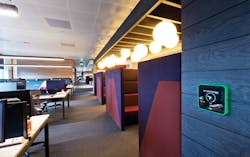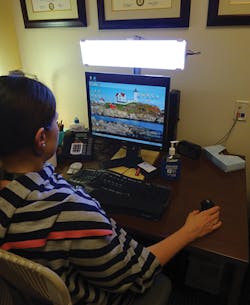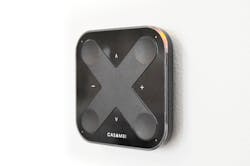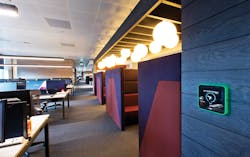There's still no empirical link with productivity, but common sense says that a happier, healthier employee is a better worker. In a two-part series, MARK HALPER finds offices that are taking to tunable LEDs to boost the circadian cycle.
Call it what you will — human-centric lighting, circadian lighting, lighting for biology, or choose your own catchphrase. But whatever you call it, there's no escaping the claim that properly tuned lighting can foster desirable conditions in human beings throughout a 24-hour period.
And there's no light source as "tunable" as an LED, a light-emitting diode which, by virtue of its digital nature, can deliver light at made-to-order color temperatures, spectral power, color, and brightness.
Simply put, human-centric lighting can stimulate people during the morning and afternoon when alertness is in order, and it can relax them at night. It can tune to the same levels that the Sun delivers, and thus reinforce the circadian rhythm that millions of years of sunrises and sunsets and 24-hour periods of day and night have instilled.
If designers also mix in as much natural daylight as possible to a palette of LED hues, the ramifications are enormous. Common sense says that stimulation and thus alertness could buoy learning and productivity. Relaxation could aid sleep. Conversely, the wrong light at the wrong time could ruin those things. Some researchers believe it contributes to cancer, diabetes, and other maladies.
The principles of tunable human-centric lighting (HCL) could apply anywhere — in schools, offices, hospitals, homes, you name it.
A year ago, LEDs Magazine explored the subject in a two-part series, looking first at HCL applications in healthcare settings, and then in offices. We found examples in both settings, particularly in hospitals, where LEDs tuned at certain times of the day to stimulating blue frequencies and at others to relaxing warmer tones helped patients sleep and heal.
The office examples seemed to be at an earlier stage of exploration and analysis. Whereas in hospitals it's easier to chart cause and effect, offices lack the monitoring equipment that's typically in place at a hospital. The upshot is that there is less empirical evidence in an office setting. Thus, HCL can be a difficult sell, if, say, a corporate buyer wants irrefutable proof that a finely engineered lighting system can boost morale and its kindred spirit, productivity.
Nevertheless, common sense would say that a properly lit workplace might well be a more productive workplace.
The science is still evolving. And experts disagree on which light properties trigger which reactions. For example, see what Deborah Burnett of Benya Burnett Consultancy had to say at the recent Lighting for Health and Wellbeing Conference (p. 36), in regard to blue energy as part of the spectral power distribution rather than just relying on CCT.
But there are plenty of early adopters. So in another two-part series, we've rounded up several examples where offices are deploying the precepts of HCL (we'll explore Benya Burnett's spectral power ideas in our next issue). These are a mix of studies and full-on deployments, but they are all pioneering illustrations of HCL in the workplace.
General Services Administration: A daily dose of light
Mariana Figueiro, the director of Rensselaer Polytechnic Institute's Lighting Research Center (LRC), has long hypothesized that the correct circadian light in offices during the day could help workers sleep better at night and could help keep their spirits up. Now she knows it does.
After a three-year study at five different General Services Administration (GSA) buildings in the US, the LRC and the GSA together reported last May that "office workers who receive a robust dose of circadian-effective light in the morning, from electric lighting or daylight, experience better sleep and lower levels of depression and stress, than those who spend their mornings in dim or low light levels."
The study involved 109 participants who wore an LRC-designed electronic pendant called a "daysimeter" to measure light intake including an LRC metric called "CS" for circadian stimulus. CS ranges from a low of 0.1 to a high of 0.7. The 0.7 represents the circadian stimulation of natural daylight, which is the ideal light for stoking up. If light were applied in the nighttime hours when the sleep-related hormone melatonin is produced, then a 0.7 CS would suppress melatonin by 70%.
Figueiro and crew found that workers who were exposed in the morning to a CS of at least 0.3 "exhibited greater circadian entrainment, were able to fall asleep more quickly at bedtime, and experienced better-quality sleep than those receiving a morning CS of 0.15 or less." They also "exhibited greater circadian entrainment," the results stated. Circadian entrainment is a measure of how strongly the body clock is tuned to natural day/night patterns.
Participants wore the daysimeter for seven consecutive days in the winter, and also for seven consecutive days in the summer. Results showed that the sleep benefit of a CS at 0.3 or higher was even stronger during the winter months, when participants receiving a low CS took about 45 minutes to fall asleep. The stress reduction advantages associated with a 0.3 CS or higher was consistent across winter and summer months. And while morning doses of 0.3 CS or higher were the most beneficial, the study revealed that an entire day's worth — 8 a.m. to 5 p.m. — also improved sleep and reduced depression.
A day for a night
"I was not surprised by the results," Figueiro told LEDs Magazine. "It's something we were expecting. Light during the day matters. There's a lot of talk about light in the evening and light from your cellphone displays before you go to bed (keeping you up at night). All of this is important. But people are not talking about light during the day. We spend 80%, 90% of our time indoors. We spend at least two-thirds of our day in our offices. And people are not talking about how important the lighting is in the offices to help you sleep better at night."
One group talking about this strategy is the GSA, which hosted the study at five locations: the GSA Central Office in Washington, DC; the Edith Green-Wendell Wyatt Federal Building in Portland, OR; the Federal Center South Building 1202 in Seattle, WA; the Wayne N. Aspinall Federal Building and US Courthouse in Grand Junction, CO; and the GSA Regional Office Building in DC.
"We are supporting this type of research so we can learn more about the connections between lighting and health," said Bryan Steverson, program advisor for the GSA's office of federal high-performance buildings. "The data from this research will help support our efforts in developing new lighting practices that can optimize health benefits for federal employees working in our federal buildings."
The 3-year LRC/GSA work served as what the LRC's Figueiro described as "Phase 1" of a three-stage study. Notably, Phase 1 did not involve tuning lights. Rather, it measured the light that participants received from existing light sources, which was a combination of natural daylight and conventional fluorescent office lights. It did not even entail LED light sources.
In research parlance, the GSA study did not use any "intervention."
But with the 0.3 CS level very much in mind, the LRC recently completed a short-term Phase 2 intervening with tunable LEDs. And at the time of this writing, it was expecting to soon extend its tunable LED work to Phase 3.
The idea is to tune direct doses of LED light to a 0.3 CS by increasing the quotient of short-wavelength blue frequencies (around 470 nm) at low lux levels, or by jacking up lux levels on white light, or by any in-between variation.
In Phase 2 at two federal locations in the summer and fall of 2016, the LRC mounted LED panel lights behind workers' computer screens, pointing straight at the eyes of about 40 participants split between the Federal Highway Administration headquarters in DC and at the Veterans Administration facility in White River Junction, VT (Fig. 1). The LRC took one day of baseline readings without the LED light, and two days of readings with it.
(Photo credit: Lighting Research Center.)
The eyes have it
Rather than measuring the effect on nighttime sleep, stress, and depression as it did in Phase 1, LRC scientists took note of any stimulating effects. The hypothesis was that a blast of 0.3 CS straight at the eye should indeed induce alertness. That's because when light hits the retina's non-visual receptors — known as ipRGCs (for intrinsically photosensitive retinal ganglion cells) — it excites a pigment called melanopsin. Not to be confused with the sleep-related hormone melatonin (and many people do indeed muddle the two together), melanopsin sends signals to the brain that stir up the body's master clock, establishing a circadian connection first discovered by Oxford University neuroscientist Russell Foster and others in the early 1990s.
The result of Phase 2 and the LEDs: "With the intervention, we showed that subjects were self-reporting being more alert, less sleepy, and having more energy," Figueiro told LEDs. "We collected the data in the winter and we showed that if you're adding a light that delivers the circadian stimulus of 0.3, you were increasing their subjective feelings of alertness, and reducing sleepiness and increasing energy and vitality."
The LRC noticed similar results in what Figueiro described as "Phase 2B," mounting the same lights for a short period of time earlier this year at US embassies in Reykjavik and Riga. That study was co-funded by the GSA and the US Department of State.
Now, it's on to Phase 3, in which the LRC will apply the LED panel lights for two weeks at a time rather than for the two days of Phase 2, while also taking a week of non-intervention readings. It will also examine the effect on sleep, stress, and depression — as in Phase 1 — as well as on alertness. When LEDs spoke with Figueiro in July, the final locations had not yet been determined, but GSA, State Department, and FHA facilities in DC were all under consideration.
Phase 3 is expected to help further demonstrate the potential effectiveness of tuning LEDs for circadian benefit. It should also back up Figueiro's assertion that healthy lighting should be delivered in "layers," in which ambient lighting could, for example, come from ceiling fixtures while circadian stimulus could come from low-lux blue frequencies aimed at the retina. While light aimed directly at the eye might sound like a turnoff, Figueiro noted that at the low level of 30 lx, the blue still stimulates but does not cause annoying glare. "If you do the 470 nm you only need 30 lx, so people found it very comfortable," she said. "You don't even see it as much because you have the ambient light, and the blue light blends in."
While LED tunability holds tremendous potential, Figueiro was also clear that office designers must embrace daylight.
"One of the things we learned is that daylighting design has to be much more improved to be able to deliver that circadian stimulus that we need," Figueiro said. "Daylight is the best circadian stimulus. The thing is, it's not always brought into the space the way it should be."
Registers of Scotland gets tuned up
If you can't have natural light beaming on you all day in the office — and who can — then tunable LEDs isn't a bad way to go.
To that end, Finnish controls company Casambi has a prescription: wireless Bluetooth controls that adjust color temperatures and can help deliver stimulating blues at the right time of the day and dial them down when required, either in an automatic pre-programmed manner or in a made-to-order way (Fig. 2).
(Photo credit: Casambi.)
"The main thing really is the color temperature control," said Casambi CEO Timo Pakkala. "One of the phrases that we've been using for offices is 'lighting that's fit for purpose.' When people talk about human-centric lighting, it's the color temperature control. It's definitely happening, but it's also very early days. One of the reasons it's still early days is it's a bit of chicken and egg. You not only need new light sources, but you also need new controls."
While gear from Casambi controls lights at thousands of locations in a multitude of countries, no more than 10% of those installations are yet deploying adjustable CCT.
But the percentage is growing. And perhaps there's no more logical place to install it than at a new construction, which provides a fresh engineering canvas.
One such place is the 12-story St. Vincent Plaza building in the middle of Glasgow, which opened late last year. When government agency Registers of Scotland took over the third floor a few months later, it embraced the HCL concept with a Casambi system that controls some 300 LED lights across 17,300 ft2.
Registers, which oversees land and property deeds, has divided the LED ceiling lights into 8 groups across the open-plan portion of the space, plus 12 meeting rooms. Each group and room has its own iPad controls — they are wall mounted in the open-plan section — which can alter brightness and color temperature, according to Registers facilities manager Kevin Stewart (Fig. 3).
(Photo credit: Casambi.)
And according to Casambi UK and Ireland business manager Stephen Jackson, the lights are pre-programmed to change color temperatures throughout the day. They drive the suspended LED ceiling lights from German architectural LED lighting provider Lightnet that reside over every desk in the open office. They also control spots from two Italian companies, iGuzzini and Targetti.
Along with the pre-programming, the iPad controls permit Registers to alter the settings. While the agency has indeed played with brightness, it has thus far not fiddled much with color temperature settings.
"We've just been in the building for six months, and we're just getting to know the system," said Registers' Stewart. "We want to go through a whole year to gather data to best inform us." After that — starting around February — Registers will almost certainly tinker more with the CCT.
Thus, to the average eye in the office, the CCT generally stays an off-white all day, even though the level subtly shifts. One place where it's programmed to a more relaxing amber tone is the office's socializing area, where employees eat and relax, and where the interior includes wood panels. There, the amber tones "bring out the ambience," Stewart noted. Much of the area can also flexibly partition into conference rooms, in which case the Casambi system can switch to a cooler CCT.
The agency has even installed a few Philips Hue lights that can change colors, although neither Stewart nor Jackson were aware of any instances of Registers using them yet.
LEDs Magazine will endeavor to follow the colorful progress.
Editor's note: In Part II, we'll uncover stellar uses of natural light and of spectral power distribution at distinctive commercial buildings in Washington, DC, Seattle, and elsewhere.
MARK HALPER is a contributing editor for LEDs Magazine, and an energy, technology, and business journalist ([email protected]).








